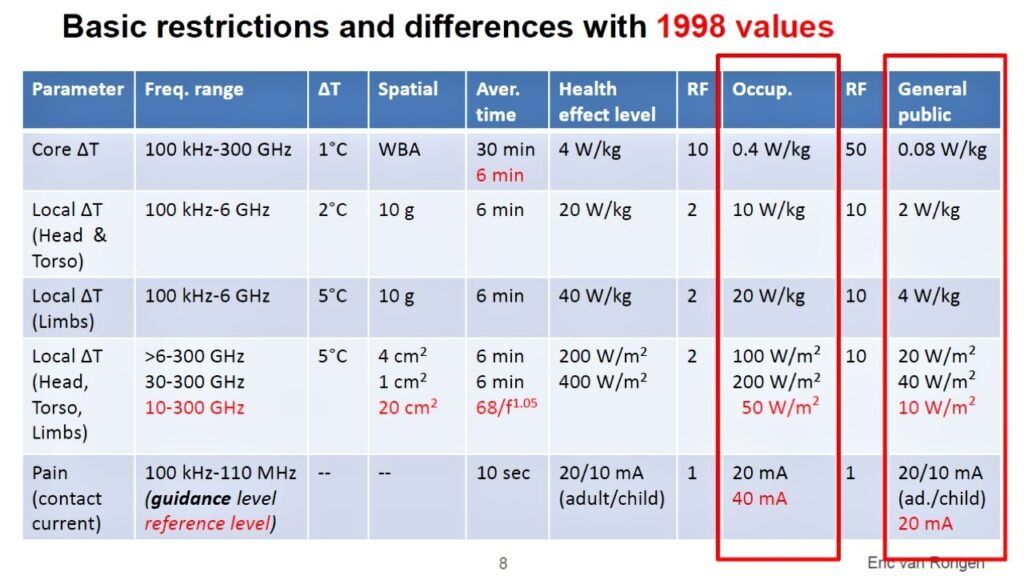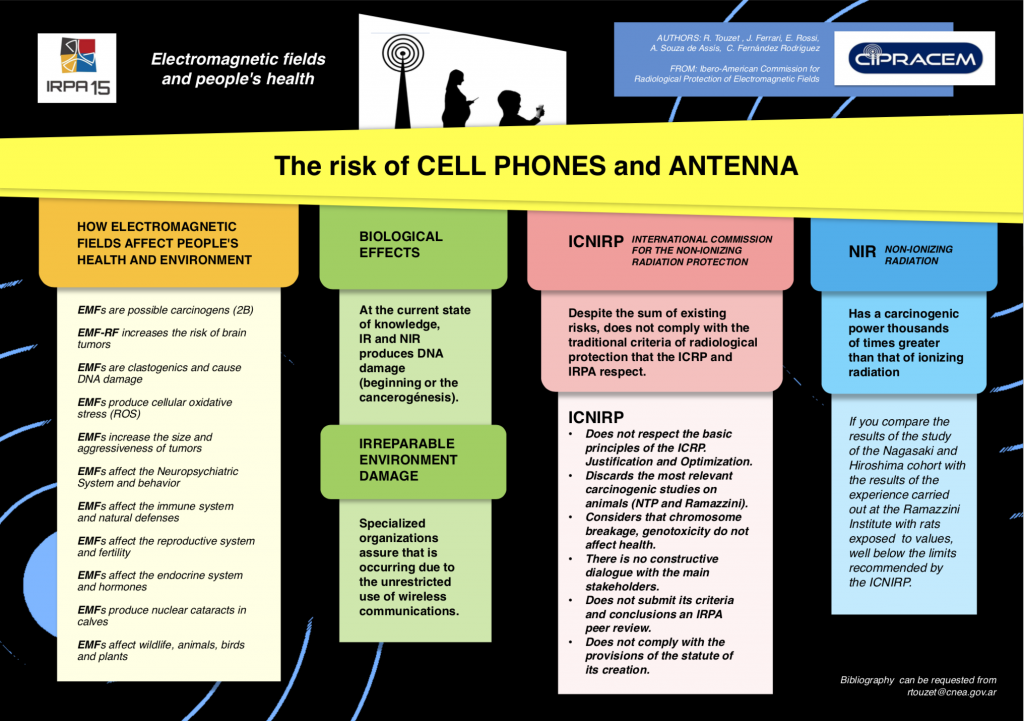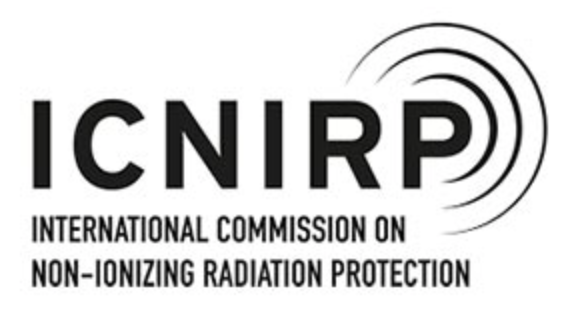For more detailed info see 2.07: FAQ
The International Commission on Non-Ionizing Radiation Protection (ICNIRP) has long been influential in EMF regulation: its scientific recommendations to WHO were first issued in 1998, updated in 2009, and revised and updated again in March 2020.
They are based on thermally induced (tissue heating) effects only, which have been undermined by thousands of papers demonstrating serious biological effects at non-thermal levels, and at orders of magnitude below current ICNIRP guideline exposure levels.
Whilst the guidelines were updated in 2020, these updates increased the maximum exposure times and increased the levels of exposure to allow for further thermal exposure, but continue to ignore the biological effects.
June 2023: Former ICNIRP member James C Lin published yet another article in IEEE Microwave Magazine on the lack of health protections in current FCC and ICNIRP wireless radiation limits.
October 2022 New Challenge to ICNIRP: Dissident Scientists Seek Tighter Health Limits. Will They Succeed Where Others Failed?
June 2022: Self-referencing authorships behind the ICNIRP 2020 radiation protection guidelines
General public exposure within 50m from a mast and under 5m drop from the antenna : for 6 minutes !! 87 V/m whole body average
Occupational exposure within the Exclusion Zone, very close to the mast: for 6minutes !! 194 V/m whole body average
Consider that Peak exposure above about 2 V/m is known to be damaging at a non thermal level …..

The risks from microwave radiation remain ‘hotly debated’, despite the wealth of credible evidence which demands a Precautionary Approach across the board.
The ICNIRP guidelines, as well as any measurements of radiation levels and the criteria for distance derived from them, are inadequate to guarantee physical safety and should not be used as standards through which to determine safety. This means that any claim of safety is unjustifiable.
When it comes to the safety of the ICNIRP guidelines the reality of the scientific controversy must be taken into account. Even a reduction factor of 50 does not guarantee safety since the ICNIRP guidelines do not provide any reference framework for demonstrated non-thermal biological effects.
Cellular Phone Use and Risk of Tumors: Is ICNIRP “war-gaming the science”?
The Telecom industry has been “war-gaming the science” since 1994 (Microwave News, January/February 1997; p. 13). In 2019, Investigate Europe, a team of journalists, published 22 news articles in eight countries that alleged the International Commission on Non-Ionizing Radiation Protection (ICNIRP) has serious conflicts of interest. Moreover, these journalists reported that in order to defend ICNIRP’s weak radio frequency (RF) exposure limits which are widely promoted by the World Health Organization, members of ICNIRP have been actively engaged in a campaign to undermine the credibility of peer-reviewed science that finds low-intensity RF radiation is harmful
Joel Moskowitz PhD May 2021
Conclusion “ICNIRP’s conclusion (48) on cancer risks is: “In summary, no effects of radiofrequency EMFs on the induction or development of cancer have been substantiated.” This conclusion is not correct and is contradicted by scientific evidence. Abundant and convincing evidence of increased cancer risks and other negative health effects are today available. The ICNIRP 2020 guidelines allow exposure at levels known to be harmful. In the interest of public health, the ICNIRP 2020 guidelines should be immediately replaced by truly protective guidelines produced by independent scientists.”
May 24th 2021
Breaking news: The urgent need to apply the ICRP criteria to Non Ionizing Radiation.
The ICRP are the parent body to whom the ICNIRP report. At their 2021 conference some serious challenges were made against the ICNIRP stance and conflicts of interest.
https://www2.irpa.net/members/TS5a.1.pdf
The ICNIRP protection paradigm seems to be wholly different to that of the IRPA which is precautionary and applicable to non linear effects. The differences have created a feeling of double standards between ionising and non ionising radiation. Radiation protection specialists working in NIR through IRPA may face some ethical problems in applying such double standards, and this could conflict with their code of ethics.

The problem with the ICNIRP is ….
The issue is that the tests were only conducted to assess short term exposure and only the so-called Thermal Effects of non-ionising radiation (NIR). The ICNIRP will not recognise any Biological effects from NIR, despite 80years worth of overwhelming evidence that exposure causes biological stress within a wide window of frequency, power and duration. This means that the RFR has to be so strong that it physically heats the organs of the body before it is restricted.
In 1998 the ICNIRP set a maximum SAR (Specific energy Absorption Rate) level at an energy density of 56 V/m (volts per metre) or 10 W/m² (watts per square meter) for exposure intervals of less than 6 to 30 minutes, as a function of time, to limit temperature rise to below the operational adverse health effect thresholds for both Type-1 and Type-2 tissues averaged on a surface area of the body of only 4cm². This has recently been reviewed but remains unchanged.
Lennart Hardell points out that ICNIRP’s pro-industry bias may explain its continued reliance only on studies of the thermogenic (heat-producing) effect of RF-EMFs in biological tissues: these studies would be expected to paint an overly benign picture of RF-EMF safety.
The current version (March 2020) of the BioInitiative 2012 website provides detailed descriptions of 988 peer-reviewed scientific studies of adverse potential health and biological effects of EMFs arising from RF and similar non-ionising sources. The vast majority (84.6%) of these 988 studies document disruptive biological effects from such EMFs, almost all of them operating via non-thermogenic pathways.
In 2008, the ICNIRP Chairman at the time, Paolo Vecchia, gave a presentation at the Radiation Research Trust Conference which included the following points:
- The guidelines are developed in such a way as to be general, and flexible. They can be adapted in principle to any realistic condition of exposure
And referring to the guidelines he states “What they are not”:
- Mandatory prescriptions for safety
- The “last word” on the issue
- Defensive walls for Industry or others
Questioning the ICNIRP Guidelines
Swiss expert group disagree with the ICNIRP 2021
District Court of Gelderland rules the ICNIRP limits unprotective
Appeals Court of Turin rules the ICNIRP unreliable and subject to conflicts of interest
This episode of BBC’s Panorama from 2007 highlights the ineffectiveness of the ICNIRP guidelines
Jeremy Vine presents ‘WiFi Warning Signal’
Call for effective exposure limits
Many scientific authorities now reject the UK government’s heating-only claim and argue for adopting biological limits, and have chosen to adopt more biologically calculated safety limits orders of magnitude below ours.
The ICNIRP do not consider that the available scientific evidence regarding reported adverse health effects at lower exposure levels justifies a more precautionary attitude. This advice now differs from a number of other authorities who have chosen to issue more precautionary maximum advisable public exposure levels for chronic (i.e. long-term) involuntary exposure.
See our page on Safer Exposure Levels
Jrs Eco Wireless – Problems with official ICNIRP exposure limits for electromagnetic radiation
This is a recent paper by Prof Henshaw – Cell Phone radiowaves have insufficient energy to cause …. damage – an enduring fallacy.
Former ICNIRP member James Lin (2004 – 2016) now advocates that wireless must get a more stringent cancer risk class. He justifies his position that there are now two large, well-executed and solid studies that point in the same direction: cancer from exposure to GSM and to CDMA – two key technologies in mobile communication. He also points out that the data in the large US NTP study, which found a clear correlation between exposure to mobile radiation and cancer rates in rats, shows even greater cancer risk than revealed in the final report.
The advisory bodies such as Public Health England, ICNIRP and the now disbanded group AGNIR (Advisory Group on Non-ionising Radiation) provide inaccurate misleading advice offering guidelines that are invalid.
Neuroscientist Dr Sarah J. Starkey published the must read paper Inaccurate Official Assessment of Radiofrequency Safety by the Advisory Group on Non-ionising Radiation, which includes a critique of AGNIR’s 2012 report, which was intended to consider evidence that RF radiation might cause health effects at exposures below those mandated by ICNIRP.
She explains that studies were omitted, included in other sections but without any conclusions, or conclusions left out; evidence was dismissed and ignored in conclusions and there were incorrect statements. Terms such as “convincing” or “consistent” were used to imply that there was no evidence. She gives many examples to support these claims. She noted that 40 studies demonstrating DNA damage are missing, 40 studies showing that electromagnetic radiation produces free radicals in the body are missing, and 22 studies demonstrating effects on male fertility.
How ICNIRP, AGNIR, PHE and a 30 year old political decision created and then covered up a global public health scandal by Simon Hodges
See also our page: Critiques of exposure guidelines and calls to account
Belgian Action
https://savebelgium.be/wp-content/uploads/2021/04/Press-release.pdf
“ICNIRP recommendations only look at short exposure times of 6 or 30 minutes and the heating effects these produce. ICNIRP does not understand how radiation affects the complex biological processes of living beings in the long term and it hardly takes them into account. Such an approach keeps on endangering humans, plants and animals. And so we take the Belgian government to court. For its negligence in protecting the population, plants, animals and the environment. For its continuing refusal to adjust radiation limits to the accumulating insights of sound and independent science.”

